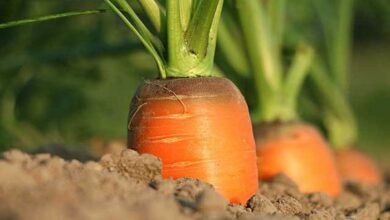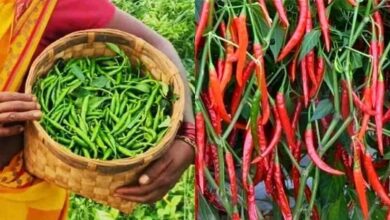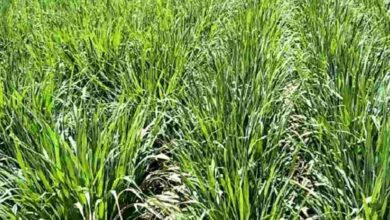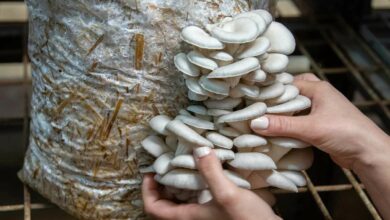Cultivation of Romanesco Broccoli: How to start growing Romanesco broccoli, know the step-by-step growing guide
Cultivation of Romanesco Broccoli: Romanesco broccoli is gaining popularity among people who are concerned about their health. It’s a peculiar vegetable that comes from Italy. Romanesco broccoli only needs little care and attention to grow, making it a reasonably straightforward crop.

What is Romanesco Broccoli?
Roman cauliflower, or Romanesco broccoli, is a special kind of vegetable with a distinctive look. Growing broccoli in Rome allows you to collect smaller servings at various periods of the season, which reduces food waste and promotes sustainability. You need to make sure that the soil has enough drainage and is nutrient-rich in order to produce Romanesco broccoli.
Position / Illumination Conditions for Broccoli from Rome For Romanesco broccoli to develop robustly and healthily, it needs to get enough sunshine. The plant requires three to five hours of direct sunshine every day, therefore it’s essential to place it in the most sunny spot in your yard.
Select a location for your Romanesco broccoli that receives plenty of sunlight all day long. Steer clear of places with excessive shadow or strong winds since they may harm plants and impede their development.
Consider growing Romanesco broccoli in pots on a sunny patio or balcony if you don’t have enough room. In this manner, you may have a vast outdoor garden area without sacrificing the freshness and flavor of your farmed fruit.
Soil Requirements
Although it may seem difficult at first, having the correct tools and perseverance may make starting your own Romanesco broccoli farm a pleasant experience. The first step is to choose the best place to plant. Choose a location in your garden that gets daily sunshine.
When you have selected the ideal spot, it is time to begin planting. To start, plant seeds in half-inch deep seed trays either inside or in a greenhouse.
To give your plants ample room to develop and spread out, make sure you place them two feet apart when you plant outside. Romanesco broccoli grows best in well-draining soil that has a pH of 6.0 to 7.5, so be aware of the soil’s pH level. By doing this, you can make sure that the plants get enough solar energy to develop into healthy heads.
You may need to adjust your soil by adding lime to boost the pH value or sulfur to reduce it if the pH level is too high or too low. It is crucial to complete this step correctly since an uneven pH level in the soil might have an impact on nutrient absorption.

The success of your Romanesco broccoli plants depends on where you put them. When it comes time to harvest, giving them enough of sunshine and making sure the soil is right for planting will provide them a solid base for growth and produce tasty results.
An essential first step in establishing a Romanesco broccoli farm is propagation. Transplanting seedlings from a nursery or utilizing seeds are the most effective methods for multiplying this unusual plant. Whatever propagation strategy you decide on, it’s critical to make sure your soil has enough nutrients and adequate drainage to support good development.
Planting Broccoli in Rome
Establishing Romanesco Sowing broccoli seeds is an essential part of farming. Sow the seeds in nutrient-rich soil that is ½ inch (1 cm) deep in seed trays. When they get to be 4 or 6 inches tall, keep them indoors or in a greenhouse.
When the seedlings are large enough, transplant them into your garden bed, being care to leave approximately two feet between each plant. Even though it might appear like too much room, this is necessary for the best possible growth and development.
Plants should be spaced apart to help avoid overcrowding, which may result in stunted growth and a greater vulnerability to pests and illnesses. All sections of the plant get enough ventilation and sunshine because to the extra spacing.
Water your Romanesco broccoli plants often until their roots are well established, starting as soon as you transplant them into your garden. Having enough water will promote healthy root growth, robust plants, and high-quality food.
Dill is a fantastic plant to grow with Romanesco broccoli. Dill draws helpful insects to your garden, such as lacewings and ladybugs, which aid in pest control and pollination. Another great vegetable to grow next to Romanesco broccoli is artichokes. Romanesco Broccoli grows well with beets, carrots, celery, cucumbers, spinach, beans, oregano, peas, potatoes, sage, and thyme as companion plants.
It gives the plant the nutrition it needs to develop and produce healthy heads. It is advised to prepare the soil with a balanced fertilizer that contains potassium, phosphorus, and nitrogen before to planting. By doing this, you can make sure the soil has adequate nutrients for the plants to develop and absorb. It’s crucial to fertilize throughout the growth season at predetermined intervals.
It’s important to avoid overfertilizing since this might cause an excessive amount of leaf growth rather than head creation. After fertilizer is applied, it’s crucial to properly water the soil to assist the fertilizer disperse throughout the soil.
For individuals who prefer natural means of feeding their plants, organic fertilizers like compost, bone meal, or fish emulsion are ideal choices. On the other hand, synthetic fertilizers like urea or ammonium nitrate might provide quicker results but can have adverse effects on the environment if used excessively. The secret to a plentiful crop of nutritious and delicious Romanesco broccoli is proper fertilizing.
Pruning is essential to increase yields
Growing Romanesco Broccoli requires careful pruning. To encourage growth and boost harvests, certain plant portions are chopped off. When the plants are young and healthy, pruning should be done, ideally after four or five leaves have developed.
Dead or diseased leaves may need to be routinely pruned off. To avoid infection, always prune your plants using clean, sharp equipment.
In addition, any flower heads that emerge before they are completely developed must be removed during pruning since this might take important nutrients away from broccoli heads that are still forming. When it comes time to harvest, Romanesco broccoli benefits from regular trimming, which also encourages rapid growth and larger harvests.
How long does it take to grow?
Romanesco broccoli is a distinctive, nutrient-dense, and easily-grown vegetable. With the appropriate planting methods, sufficient sunshine, and the suitable soil conditions, you can grow this plant in your garden or on a bigger farm. It can take those stunning heads 80–100 days to reach their peak maturity.
Controlling Pests and Diseases
Romanesco broccoli is prone to pests and illnesses, much like any other crop. The cabbage worm is one frequent pest that has an impact on this plant. If left unchecked, these little green caterpillars may swiftly eat your vegetation.
Aphids and cabbage worms are two more common issues producers face with Romanesco broccoli. If these insects are not removed right away, they may seriously harm the fragile leaves and blooms of this plant. You may stop these pests from damaging your crop by using natural companion planting.
The health of your crop might also be threatened by fungal diseases like downy mildew or root rot, in addition to insect infestations. Make sure your plants have enough drainage by not giving them too much water to prevent these problems.
Maintaining proper garden hygiene is essential to keeping these pests away from your produce. As soon as possible, remove any dead or rotting material and dispose of it somewhere other than your growing area.
In order to manage infestations before they become a significant issue, you may also use organic pesticides like neem oil or insecticidal soap.
Diseases that may harm Romanesco broccoli include clubroot and powdery mildew. Plants with powdery mildew on their leaves and swollen roots due to clubroot cause wither the plants.
Ensuring appropriate soil drainage via watering procedures and keeping optimum airflow around the plants are key to preventing these diseases. Rotating your crops each season can also help keep diseases from building up in the soil.
Problems Related To Growth
Romanesco broccoli is an intriguing and tasty vegetable, but like any plant, it may have growth issues. The sluggish maturity of Romanesco broccoli is one of the most typical problems with it. To make sure your plants are healthy and growing correctly, you may need to give them additional care and attention.
The inability of Romanesco broccoli to develop heads correctly is a problem that many farmers encounter. This might be caused by a number of things, such insufficient light levels during the development of seedlings or poor soil nutrients. Before taking harsh actions like replanting, consider altering your plants’ surroundings if they aren’t growing heads appropriately.
Growing Romanesco Broccoli in Pots
For those who live in areas with low soil quality or have limited space, growing Romanesco broccoli in pots is an excellent choice. If you need to change how much sunshine your plants get, it’s also an easy method to do it.
Make sure the pot you choose includes bottom drainage holes to allow for optimal water movement. Add some organic fertilizer to the container along with some well-draining soil to provide nutrition.
Make sure your plants get six hours or more of direct sunshine each day, and water them often, but not too much since this might cause root rot.
As your Romanesco broccoli gets bigger, think about adding stakes or trellises for support. This will stop it from bending or shattering from its head’s weight. Romanesco broccoli harvested from pots is comparable to broccoli harvested from garden beds.
Why Aren’t Romanesco Broccoli Heads Forming?

When growing Romanesco broccoli, one typical issue you could run into is the plant not being able to create heads. Romaresco Broccoli may not form heads for a number of reasons. Insufficient exposure to sunshine or irregular frequency of watering might be one factor. Make sure your plants get six hours of sunshine a day or more, and water them often enough to maintain the soil’s moisture content without becoming too soggy.
Unbalanced soil pH levels or nutrient deficiencies might be other contributing factors. Before planting, make sure your soil has enough nitrogen, phosphorous, and potassium by adding organic matter, such as compost or manure. Using a kit from your neighborhood garden center, determine the pH of your soil and make any required adjustments. Aphids and cabbage worms are two pests that may harm early buds before they become fully formed heads. Regularly look for indications of pest infestation, and treat afflicted plants right once with natural insecticides such as sprays containing pyrethrin or neem oil.
How and when should harvesting be done?
Romanesco broccoli picking is essential to get the healthiest and best-tasting food. Picking it too early or too late might alter its taste and nutritional value, thus time is crucial when harvesting. One of the most satisfying parts of producing Romanesco broccoli is harvesting this unusual and tasty crop. Timing is crucial when it comes to harvesting. you preserve the taste and texture of your broccoli, be sure you pick it at the appropriate time.
The time to harvest your Romanesco broccoli should be determined by keeping an eye on the head development. Buds should be closely spaced and the head should be robust and compact. It’s time to harvest if you see some blossoms opening.
When harvesting, trim off the stem below the main head using a sharp knife or pair of scissors. This may result in more harvests later in the season by promoting the formation of side shoots. When the broccoli is gathered, place it in a plastic bag and refrigerate it until you’re ready to use it. With appropriate storage, it may last for many days. After the seeds are sown, the heads are ready to be harvested after 80–100 days.
In summary
Hardy and suitable for a chilly climate, Romanesco broccoli is well-known for its tasty, richly colored leaves. It thrives on sunny, well-drained soil that is rich in nutrients. Growing broccoli in Rome has several advantages beyond just producing a tasty and distinctive crop for your diet. Its ability to be cultivated year-round makes it a great option for both indoor and outdoor planting, which is one of its main benefits.





